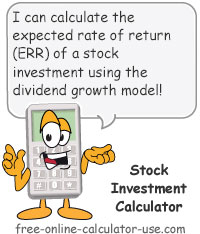IMPORTANT: Numeric entry fields must not contain dollar signs, percent signs, commas, spaces, etc. (only digits 0-9 and decimal points are allowed).
Click the Terms tab above for a more detailed description of each entry.
Step #1:
Enter the current dividend per share.
Step #2:
Enter the current price per share.
Step #3:
Enter the stock growth percentage.
Step #4:
Click the "Calculate Expected ROR" button.


Follow me on any of the social media sites below and be among the first to get a sneak peek at the newest and coolest calculators that are being added or updated each month.